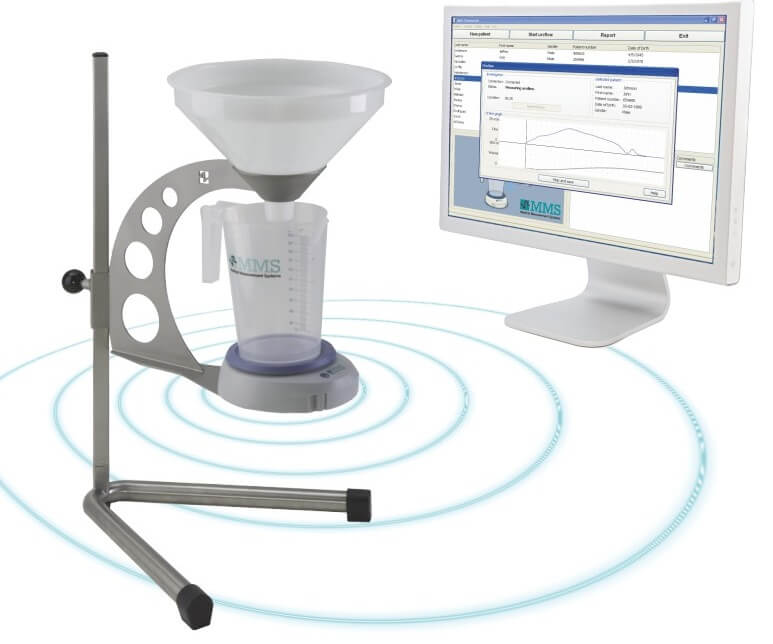What is Uroflowmetry ?
Uroflowmetry is a test by which the flow of urine from the body is measured and the functionality of the urinary system is assessed. During the test, the patient urinates into an uroflowmetry device, which is basically a urinal with sensors. It records the flow rate and volume of urine expelled over a specific period. The patient is instructed to urinate naturally without any forceful efforts or interruptions.
The Uroflowmetry test measures several parameters, including:
- Voiding Time: The duration of time taken for the patient to empty their bladder.
- Maximum Flow Rate: The highest rate of urine flow during the voiding process. This parameter is essential in assessing the efficiency of the urinary system.
- Average Flow Rate: The average speed of urine flow throughout the voiding process.
- Voided Volume: The total amount of urine expelled during the test.
Why is uroflowmetry test done ?
Your doctor will recommend a uroflowmetry if you experience slow urination or trouble while urinating. They might also use this test to check the sphincter muscle that closes around the opening of your bladder, which prevents the leakage of urine.
A uroflowmetry test will help your doctor determine how well your sphincter muscle and bladder are functioning. The test can even be used to check the obstructions in the normal flow of your urine. After completing the test, your doctor will be able to say whether you have an enlarged prostate or weakened bladder or if you have any other urinary problems. Here are some specific purposes for which uroflowmetry is used:
1. Assessing Urinary Obstruction: The test helps determine if there is any blockage or obstruction in the urinary tract. It is commonly used to evaluate conditions such as benign prostatic hyperplasia (BPH) in men, where an enlarged prostate gland can impede the flow of urine.

2. Diagnosing Lower Urinary Tract Symptoms (LUTS): It is used to diagnose conditions related to LUTS, such as urinary incontinence or overactive bladder. It helps evaluate the severity and type of urinary dysfunction by measuring urine flow patterns.
3. Monitoring Treatment Effectiveness: Uroflowmetry test is useful in monitoring the effectiveness of treatment interventions for urinary conditions. It allows doctors to track changes in urine flow rate, volume, and voiding time, helping them assess the response to medication or other therapies.
4. Postoperative Evaluation: After certain urological surgeries, uroflowmetry is used to check for the restoration of normal urinary function. It helps determine if the surgical procedure has successfully resolved any previous obstructions or urinary issues.
5. Assessing Neurological Disorders: Uroflowmetry aids in diagnosing and monitoring urinary problems in individuals with neurological conditions that affect bladder function, such as multiple sclerosis or spinal cord injuries.
How to prepare for uroflowmetry test?
Below are some guidelines to help you prepare for an uroflowmetry test:
1. Hydration: It is important to stay adequately hydrated before the test. Drink enough fluids to ensure a normal urine flow. However, avoid excessive fluid intake immediately before the test, as it can affect the accuracy of the results.
2. Medications: Consult your doctor regarding any medications you are taking. They will advise you whether to continue or temporarily discontinue any specific medications that may interfere with the test. Follow their instructions carefully.
3. Time your bladder: It may be helpful to estimate your bladder’s natural timing before the test. Take note of when you typically feel the urge to urinate and try to follow a similar schedule on the day of the test. This can help ensure that your bladder is adequately filled before the procedure.
4. Voiding diary: In some cases, your doctor might ask you to maintain a voiding diary leading up to the test. It typically includes information about your fluid intake, urination frequency, and any unusual urinary symptoms. Follow any specific instructions provided to you regarding the diary.
5. Communicate with your doctor: If you have any specific concerns or questions regarding the test, do not hesitate to discuss them with the doctor beforehand. They can provide you with instructions based on your individual situation.
How do I check my uroflowmetry report?
Once you have the report, carefully pay attention to the following key components:
1. Voiding Time: This indicates the duration it took for you to empty your bladder during the test.
2. Maximum Flow Rate: This represents the peak rate at which urine flows during urination, typically measured in millimeters per second (mL/s).
3. Average Flow Rate: This indicates the average speed of urine flow throughout the voiding process, also measured in mL/s.
4. Voided Volume: This refers to the total amount of urine expelled during the test, usually measured in millilitres (mL).
While you may be able to understand the uroflowmetry test results normal range in the report, it is important to consult with your physician for proper interpretation. They will assess the results in the context of your specific medical history, symptoms, and any previous diagnostic tests. They will explain the implications of the findings and provide guidance on any necessary further actions or treatments.
Long Life Support
We use cutting-edge equipment for all our Uroflowmetry test in our Mukndapur centre, follow strict processes and have highly experienced and trained doctors, technicians, surgeons, nurses and support staff to make sure that each test yields perfect results.
Make an Enquiry
Contact Details
Location :
Phone No :
Whatsapp No :
Email ID :
info@longlifenet.in
